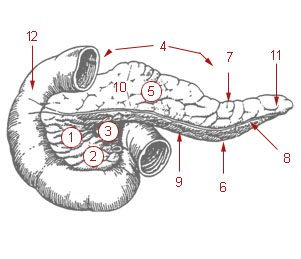

Risk factors for this condition include smoking, obesity, diabetes, as well as the presence of colon cancer. Pancreatic cancer:This kind of cancer is particularly dangerous because it is usually only caught in a very late stage.Treatment often entails surgically removing the pancreas, which is effective but means the patient will have to take supplemental enzymes and blood glucose regulators for the rest of their life. In turn, this can damage the pancreas, itself, as well as other organs in the area. Perforation: Disorders in pancreatic structure can lead to holes in the organ, in which case digestive enzymes leak into the abdominal cavity.It’s here that you find the primary pancreatic duct that secretes insulin and digestive enzymes.
 Tail: The narrowing end of the pancreas represents its tail, which lies just in front of the left kidney. Body: Widening after the neck, the body of the pancreas crosses the center of the body, with its front portion enclosed in the peritoneum (the dense layer of tissue that surrounds the abdomen), and its rear touching the aorta, the superior mesenteric artery, and left kidney, among other anatomical structures.
Tail: The narrowing end of the pancreas represents its tail, which lies just in front of the left kidney. Body: Widening after the neck, the body of the pancreas crosses the center of the body, with its front portion enclosed in the peritoneum (the dense layer of tissue that surrounds the abdomen), and its rear touching the aorta, the superior mesenteric artery, and left kidney, among other anatomical structures. 
Neck: Usually measuring only about 2 cm, the neck of the pancreas connects the head with the body. This section also has a bile duct, which plays a role in digestion. Projecting downward from the left, at lateral border is the uncinate process, a small portion of the organ that joins with the superior mesenteric vein. It lies against the descending and horizontal portions of the duodenum, which has a C-shape. Head: The head of the pancreas is, as the name implies, the widest portion of the organ.







 0 kommentar(er)
0 kommentar(er)
